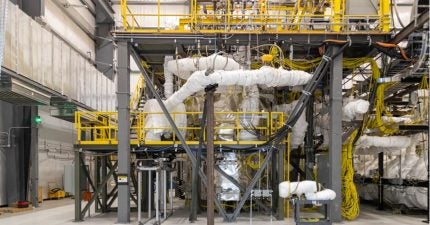
Kairos Power has completed testing on the largest FLiBe (fluoride-lithium-beryllium) molten salt system ever built. The company’s first Engineering Test Unit (ETU 1.0) is now undergoing decommissioning at its manufacturing facility in Albuquerque in New Mexico after more than 2,000 hours of pumped salt operations.
ETU 1.0 is the first of three systems that are being built to inform the design, construction, and operation of Hermes – a low-power reactor that the company is using to advance the development of its fluoride salt-cooled high-temperature reactor (KP-FHR) technology.
ETU 1.0 started operation last December and used 12 tonnes of FLiBe salt coolant produced at its Molten Salt Purification Plant in Elmore, Ohio. The system was filled with 30,000 surrogate fuel pebbles and more than 300 graphite reflector blocks to replicate conditions inside the Hermes reactor core.
Over the course of six months, Kairos Power put ETU 1.0 through its paces with thousands of hours of regular operation, as well as ests designed to simulate failure scenarios. These included a primary pipe break and freezing of the salt coolant. At its peak, the system reached 675 degrees Celsius and a salt flow rate of 3,000 gallons per minute.
Control room staff monitored ETU 1.0 around the clock and collected more than 10 terabytes of performance data in addition to analysing salt samples and inspecting 1,673 surrogate fuel pebbles.
“With our iterative approach, Kairos Power aims to learn by building, and we’ve learned a tremendous amount from building and operating ETU,” said Edward Blandford, Kairos Power co-founder and Chief Technology Officer. “With this milestone, we now have the team, the knowledge, and the capabilities needed to successfully deploy Hermes and the iterations that will follow.”
Kairos Power is following a “rapid iterative development” approach to bring its KP-FHR advanced nuclear reactor to market. This means designing, building, and testing multiple prototypes, learning lessons, and improving processes along the way.
ETU 1.0 is a full-scale, electrically heated prototype of Hermes and was the first step on that path. Kairos Power has already gained invaluable insights and experience from the ETU programme, both on the technical and logistical sides. ETU 1.0 served as a vehicle for Kairos Power to exercise the supply chain and establish new capabilities in-house, including the production of high-purity fluoride salt coolant and specialised reactor components.
The next iteration of the project, ETU 2.0, is already underway in Albuquerque and will focus on demonstrating the modular design of the reactor. After that, ETU 3.0 will be built in Oak Ridge, Tennessee adjacent to the eventual site of the Hermes reactor.
Hermes is supported by the US Department of Energy’s Advanced Reactor Demonstration Program. It will use a TRISO fuel pebble bed design with a molten fluoride salt coolant to achieve a thermal power level of 35 megawatts.
In December 2023, the Nuclear Regulatory Commission approved the construction permit application for Hermes. Kairos Power plans to have the reactor operational as early as 2026. Through repetition and refinement of the design and construction process, Kairos Power aims to reduce development risk and lay the groundwork for commercialising its 140 MWe KP-FHR high-temperature molten salt reactor, which could be operational in the early 2030s.






